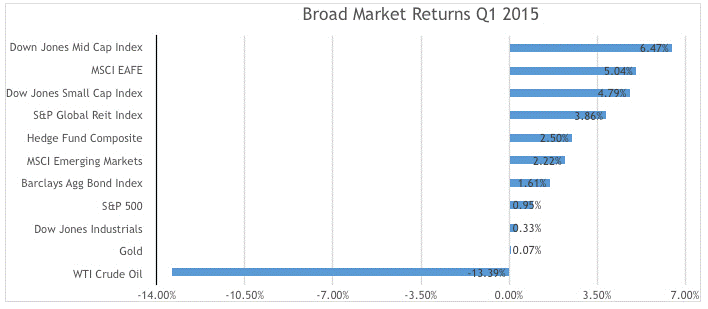Gill Capital Partners: Q1 2015 Market Commentary
“The stock market is designed to transfer money from the active to the patient.” - Warren Buffett Q1 2015 Market Commentary
Gill Capital Partners News
During the 1st Quarter Gill Capital Partners had several memorable moments:
- Gill Capital was ranked 15th on the 2014 Business Journal list of Financial Planners and Investment Managers, based on assets under management.
- James O’Brien began his 1st year as President of the Denver Chapter of the Financial Planning Association (FPA).
- Tom Cladis was invited to join a roundtable discussion with Kansas City Federal Reserve Bank President Esther George at the Denver Federal Reserve to discuss views on the economy and the current bond market.
- John Winslow was featured in the Denver Business Journal reflecting on what we believe are the biggest issues facing our industry.
Market Overview
Proper asset allocation and diversification worked in Q1 as large cap U.S. stocks, which had been a source of out-performance for so long, trailed most other asset classes for the quarter. International equities and small/mid-cap U.S. equities paced the gains for the quarter. Bonds posted another positive quarter, again surprising those who expected interest rates to rise. The largest movements, however, came from the oil market again, where oil prices fell sharply again as oil supplies continued to build.
The Economy
The economy demonstrated sound and largely unremarkable growth in the first quarter of 2015. The employment picture continued to exhibit steady gains without real inflationary wage pressures. The drop in oil prices aided consumer spending, but will likely be a source of employment weakness moving forward unless oil prices rebound significantly. Housing and Real Estate continue to be a source of overall strength as low interest rates, combined with a tight rental market are driving forces behind a strong residential real estate market. Similar drivers, combined with increasing demand and risk appetite for retail, office and industrial space, have created a booming commercial Real Estate market once again.
Oil Prices
Oil prices have dropped dramatically, falling roughly 60% from the peak in mid-2014. The price drop seemingly caught everybody by surprise and leaves many scratching their heads. The chart below succinctly demonstrates the issue. As the United States has experienced a drilling boom over the past few years, largely due to technological advances in fracking and shall oil extraction, we have been able to dramatically increase our domestic oil production. The supply has increased sharply as shown below, driving the prices to current levels. Experts are massively divided on the future of oil prices, but many are looking for oil to rebound to the $60-$65/barrel range within the next 12 months, and potentially stabilize at that level for a protracted period of time until the supply fundamentals can correct themselves. So how impactful will this move be on energy related companies? It depends; most energy companies hedge large portions of their production, which will serve them well this year. However, there are quite a few smaller and highly leveraged oil companies that need prices above $65/barrel or even $75/barrel to be profitable. We will likely see some level of distress associated with the debt and equity of these smaller companies the longer oil prices remain low.
The Federal Reserve & Interest Rates
Aside from oil prices, the other significant driver of asset prices over the past quarter has been the Federal Reserve and expectation of when they may begin to raise interest rates. There was an overwhelming consensus by the end of 2014 that the Federal Reserve would begin raising interest rates by mid-2015, if not earlier. Those expectations have been reduced during the first quarter as a lack of inflationary pressure, combined with deflationary pressure from around the globe, have the Fed in an awkward position. The lack of conviction in the Fed’s willingness to raise interest rates, coupled with absurdly low interest rates in Europe and Japan, has led to an environment of continued low interest rates here in the U.S. Expectations remain for Federal Reserve tightening in 2015 or early 2016.
Looking Ahead and Portfolio Allocations
In The U.S., economists remain optimistic about the prospects for continued growth. Job growth is expected to continue, with little evidence of wage inflation at this point. Households and businesses are the healthiest they have been in many years. U.S. equity prices, while high, are fairly valued. Looking globally, the economies of Europe and Japan are much more fragile with real deflationary issues presenting themselves. The recent aggressive moves by the European and Japanese central banks have propelled their equity markets higher, and further gains are likely if their easing programs begin to generate positive economic growth.
Our investment committee continues to devote significant resources to our asset allocation by investing in globally diversified portfolio. Our slight overweight to International and U.S. Mid-Cap equities served our portfolios well in the first quarter. We are also working to make sure our portfolios are insulated from any direct or secondary issues that may be created due to the sharp drop in oil prices.
Please let us know if you have any questions or concerns about this report, if there have been changes in your financial circumstances, or if we can provide assistance with any other financial matters including education, taxes, insurance, or estate needs.


